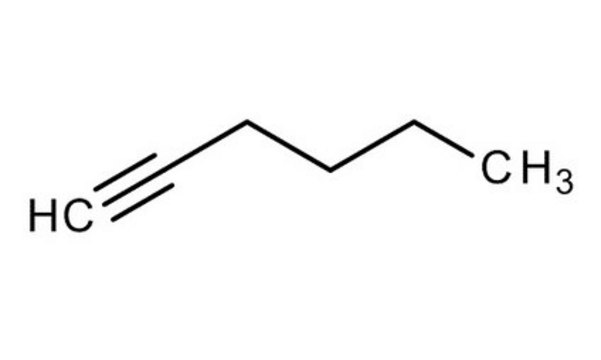244414
1-Heptyne
98%
Synonym(s):
1-n-Heptyne, Amylacetylene, Pentylacetylene
Sign Into View Organizational & Contract Pricing
All Photos(1)
About This Item
Linear Formula:
CH3(CH2)4C≡CH
CAS Number:
Molecular Weight:
96.17
Beilstein:
1733518
EC Number:
MDL number:
UNSPSC Code:
12352100
eCl@ss:
39010410
PubChem Substance ID:
NACRES:
NA.22
Recommended Products
vapor pressure
93.1 mmHg ( 37.7 °C)
Quality Level
Assay
98%
form
liquid
refractive index
n20/D 1.408 (lit.)
bp
99-100 °C (lit.)
mp
−81 °C (lit.)
density
0.733 g/mL at 25 °C (lit.)
SMILES string
CCCCCC#C
InChI
1S/C7H12/c1-3-5-7-6-4-2/h1H,4-7H2,2H3
InChI key
YVXHZKKCZYLQOP-UHFFFAOYSA-N
Looking for similar products? Visit Product Comparison Guide
Related Categories
General description
The hydrogenation of 1-heptyne with palladium, platinum and ruthenium supported on activated carbon as catalysts, was studied.
Application
1-Heptyne was used in the synthesis of (6Z,10E,12Z)-octadeca-6,10,12-trienoic acid and (8Z,12E,14Z)-eicosa-8,12,14-trienoic acid.
Signal Word
Danger
Hazard Statements
Precautionary Statements
Hazard Classifications
Flam. Liq. 2
Storage Class Code
3 - Flammable liquids
WGK
WGK 3
Flash Point(F)
14.0 °F
Flash Point(C)
-10 °C
Personal Protective Equipment
dust mask type N95 (US), Eyeshields, Gloves
Regulatory Information
危险化学品
Choose from one of the most recent versions:
Already Own This Product?
Find documentation for the products that you have recently purchased in the Document Library.
O Loreau et al.
Chemistry and physics of lipids, 124(2), 135-145 (2003-06-24)
To study the metabolic fate of conjugated linoleic acid isomers, we synthesized, in seven steps, from 1-heptyne, (6Z,10E,12Z)-octadeca-6,10,12-trienoic acid, (8Z,12E,14Z)-eicosa-8,12,14-trienoic acid, and their [1-(14)C]-analogs. In the case of (6Z,10E,12Z)-octadecatrienoic acid, a series of palladium-catalyzed cross-coupling reactions between 1-heptyne and (E)-1,2-dichloro-ethene
Cecilia R Lederhos et al.
TheScientificWorldJournal, 2013, 528453-528453 (2013-12-19)
Palladium, platinum, and ruthenium supported on activated carbon were used as catalysts for the selective hydrogenation of 1-heptyne, a terminal alkyne. All catalysts were characterized by temperature programmed reduction, X-ray diffraction, transmission electron microscopy, and X-ray photoelectron spectroscopy. TPR and
Chloë L Wright et al.
Applied and environmental microbiology, 86(9) (2020-02-23)
Ammonia monooxygenase (AMO) is a key nitrogen-transforming enzyme belonging to the same copper-dependent membrane monooxygenase family (CuMMO) as the particulate methane monooxygenase (pMMO). The AMO from ammonia-oxidizing archaea (AOA) is very divergent from both the AMO of ammonia-oxidizing bacteria (AOB)
Our team of scientists has experience in all areas of research including Life Science, Material Science, Chemical Synthesis, Chromatography, Analytical and many others.
Contact Technical Service









